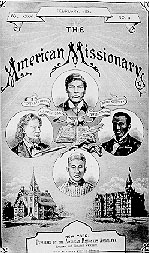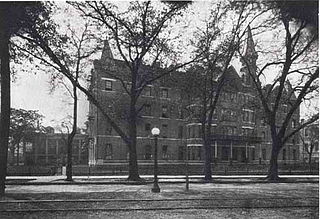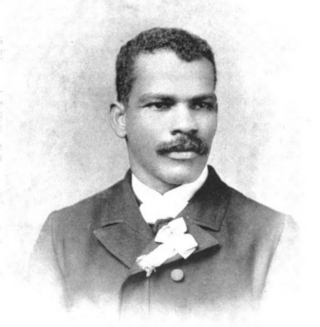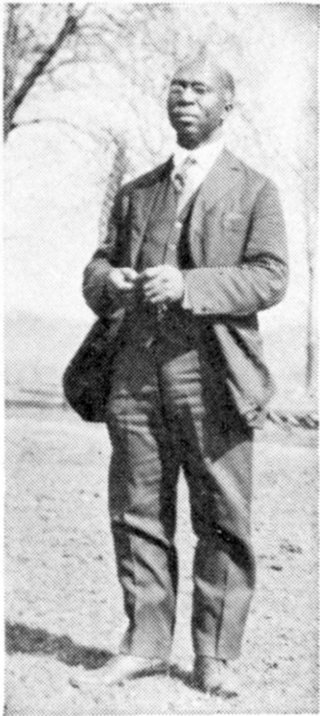
Baldwin is a town in St. Mary Parish, Louisiana, United States. The population was 2,436 at the 2010 census, down from 2,497 in 2000. It is part of the Morgan City Micropolitan Statistical Area. Its population is majority African American. The town has been home to educational institutions for white and "colored" students.
The Methodist Episcopal Church, South was the American Methodist denomination resulting from the 19th-century split over the issue of slavery in the Methodist Episcopal Church (MEC). Disagreement on this issue had been increasing in strength for decades between churches of the Northern and Southern United States; in 1845 it resulted in a schism at the General Conference of the MEC held in Louisville, Kentucky.
An African American is a citizen or resident of the United States who has origins in any of the black populations of Africa. African American-related topics include:

The American Missionary Association (AMA) was a Protestant-based abolitionist group founded on September 3, 1846 in Albany, New York. The main purpose of the organization was abolition of slavery, education of African Americans, promotion of racial equality, and spreading Christian values. Its members and leaders were of both races; The Association was chiefly sponsored by the Congregationalist churches in New England. The main goals were to abolish slavery, provide education to African Americans, and promote racial equality for free Blacks. The AMA played a significant role in several key historical events and movements, including the Civil War, Reconstruction, and the Civil Rights Movement.

Uptown is a section of New Orleans, Louisiana, United States, on the east bank of the Mississippi River, encompassing a number of neighborhoods between the French Quarter and the Jefferson Parish line. It remains an area of mixed residential and small commercial properties, with a wealth of 19th-century architecture. It includes part or all of Uptown New Orleans Historic District, which is listed on the National Register of Historic Places.

Alexander Priestly Camphor, also known as A.P. Camphor, was an American Bishop, missionary, educator, academic administrator, author, and college president. He was the Missionary Bishop of the Methodist Episcopal Church, elected in 1916. He served as president of Central Alabama College and the College of West Africa. Camphor Hall at Dillard University, New Orleans is named in his honor.

John Baldwin was an American educator, and the founder of Baldwin Institute in Berea, Ohio, which would eventually merge into Baldwin–Wallace College, now Baldwin-Wallace University. He was also the founder of Baker University and Baldwin City, Kansas, and contributed money to start schools in Bangalore, India that are today called Baldwin Boys High School, Baldwin Girls High School and Baldwin Co-Education Extension High School.

John Wesley Edward Bowen was born into American slavery and became a Methodist clergyman, denominational official, college and university educator and one of the first African Americans to earn a Ph.D. degree in the United States. He is credited as the first African American to receive the Ph.D. degree from Boston University, which was granted in 1887.

John Wesley Gilbert was an American archaeologist, educator, and Methodist missionary to the Congo. Gilbert was the first graduate of Paine College, its first African-American professor, and the first African-American to receive an advanced degree from Brown University.

New Orleans University was a historically black college that operated between 1869 and 1935 in New Orleans, Louisiana, United States. It was founded by Freedmen's Aid Society and the Methodist Episcopal Church. It merged with Straight College in 1935 to form Dillard University.

Ernest A. Lyon was an African-American minister, educator and diplomat.

Flint-Goodridge Hospital was a hospital in New Orleans, Louisiana. For almost a century (1896–1983) it served predominantly African-American patients and was the first black hospital in the South. For most of these years, was owned and operated by Dillard University, a historically black university. From 1932 until its closing in 1983 it was located on Louisiana Avenue in uptown New Orleans. Its former Louisiana Avenue facility is now listed in the US National Register of Historic Places.

Louise De Mortie was an African-American lecturer and fundraiser. She devoted herself to aiding black children orphaned during the American Civil War.
Mary Dora Coghill was an American teacher, vice principal, principal, and civic leader in early twentieth-century New Orleans. She was a member of numerous civic and relief organizations and a leader in education reform. She was an African-American.

George Soule was a Louisiana author, educator, and soldier best known for establishing Soule Business College in New Orleans around the time of the American Civil War, and presiding over that institution for over sixty years.
Luther College was a private black school in New Orleans, Louisiana, United States. It was established by the Evangelical Lutheran Synodical Conference of North America in 1903 as part of the conference's missionary work among African Americans in the Southern United States following the American Civil War. The school was founded the same year as Immanuel Lutheran College in Concord, North Carolina, and both schools had the same three departments: a secondary school, a normal school, and a seminary.
Haygood Seminary, also known as Haygood Academy, was a seminary near Washington, Arkansas, United States. It was established by the Colored Methodist Episcopal Church to train African Americans in Arkansas for a career in the clergy. It was one of the first such institutions established by the CME Church. In 1927, the school relocated to Jefferson County, Arkansas, where it operated as Arkansas-Haygood Industrial College before closing during World War II.

Robert Benjamin Hayes was an American educator, academic administrator and college president. He headed Philander Smith College's natural science department, and served as the president of George R. Smith College from 1916 until 1925.

Homer College, formerly Homer Seminary, was a private Methodist school in Homer, Louisiana. In 1880 a school was opened under the name "Homer Seminary" as an African American elementary and high school founded by members of the Colored Methodist Episcopal Church ; by 1910 the school was renamed Homer College and became part of the CME, it served as an African American college-preparatory school for Texas College in Tyler, Texas. The school closed in 1918 after a conflict of leadership.
















